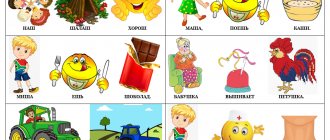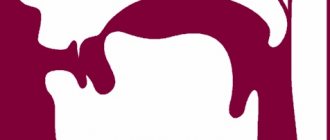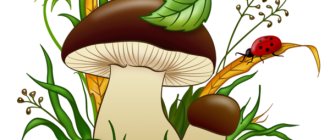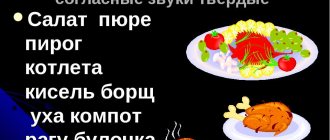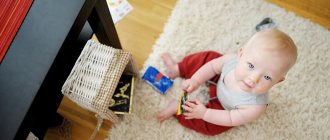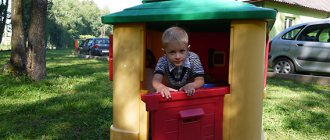KHOCHIKYAN VERA
Consultation for parents “Why articulation gymnastics is needed”
Why is articulation gymnastics needed ?
It is known that writing is formed on the basis of oral speech, so deficiencies in oral language can lead to poor performance in school.
In order for a baby to learn to pronounce complex sounds ([s], [z], [sh], [zh], [l], [r], his lips and tongue must be strong and flexible, hold the required position for a long time, and easily perform multiple transitions from one movement to another.Articulation gymnastics .
Articulatory gymnastics are exercises for training the organs of articulation (lips, tongue, lower jaw, necessary for correct sound pronunciation.
Reasons why you need to do articulation gymnastics :
1. Thanks to timely articulation gymnastics and exercises to develop speech hearing, some children themselves can learn to speak clearly and correctly, without the help of a specialist.
2. Children with complex sound pronunciation disorders will be able to quickly overcome their speech defects when a speech therapist begins to work with them: their muscles will already be prepared.
3. Articulatory gymnastics is also very useful for children with correct but sluggish sound pronunciation, about whom they say that they have “porridge in their mouth”
. We must remember that clear pronunciation of sounds is the basis for learning to write at the initial stage.
Articulation gymnastics classes will allow everyone - both children and adults - to learn to speak correctly, clearly and beautifully.
articulation gymnastics correctly ?
First, introduce your child to the basic positions of the lips and tongue with fun stories about the Tongue. At this stage, the child should repeat the exercises 2-3 times. Then repeat all the exercises with him, using cards at least 5-6 times, which will help you master all the exercises faster, and you can practice them without having additional books at hand.
Do not forget to complete tasks aimed at developing your voice, breathing and speech hearing. This is very important for correct sound pronunciation.
Repetition exercises will help you practice certain positions of the organs of articulation necessary to pronounce sounds that cause the greatest difficulties for your child.
Recommendations for exercises:
At first, the exercises should be performed slowly, in front of a mirror, since the child needs visual control. After the baby gets used to it a little, the mirror can be removed. It is useful to ask your child leading questions. For example: what do lips do? what does the tongue do? where is it located (up or down?
Then the pace of the exercises can be increased and performed countingly. But at the same time, make sure that the exercises are performed accurately and smoothly, otherwise the exercises are meaningless.
It is better to exercise 2 times a day (morning and evening)
for 5-7 minutes, depending on the age and perseverance of the child.
When working with 3-4 year old children, make sure they master the basic movements.
For children 4-5 years old, the requirements increase: movements must be more clear and smooth, without twitching.
At 6-7 years of age, children perform exercises at a fast pace and are able to hold the tongue position for some time without changes.
If during classes the child’s tongue trembles, is too tense, deviates to the side and the child cannot maintain the desired position of the tongue even for a short time, be sure to contact a speech therapist. You may need the help of a speech therapist and a special massage.
Correct pronunciation of sounds, along with a rich vocabulary and grammatically correct, well-developed, coherent speech, is one of the main indicators of a child’s readiness for schooling.
"Smile"
-stretch your lips in a smile.
"Fence"
-smile and show teeth
“Painting the lower fence”
to “paint”
from the inside . Movements up and down and left and right
-SH-
"Dudochka"
- Pull your lips forward with tension.
"Circle"
- lift the upper and lower lips, exposing the teeth close together.
"Pancake"
- open your mouth slightly, place a wide, relaxed, soft tongue on your lower lip.
"Cup"
- mouth open.
Lips in a smile. Tongue out. Raise the edges and tip of the wide tongue upward in the shape of a “cup”
. The back of the tongue is lowered.
-L- and –R-
"Window"
- open your mouth -
“hot”
, close your mouth
“cold”
.
"Swing"
- open your mouth. Lips in a smile. Use the tip of your tongue to alternately touch the upper and lower lips - up and down movements.
“Painting the top fence”
- smile, open your mouth slightly, use the tip of your tongue on the inside to “paint” your upper teeth with a “brush.” Tongue movements
up-down and left-right.
"Needle"
- open your mouth. Smile. Raise the tip of the narrow tongue up
to the cusps of the upper teeth.
Methodological recommendations for performing articulation gymnastics
1. Gymnastics lasts 10-15 minutes.
2. Perform exercises in front of a mirror
3. Perform each exercise 5 times.
4. Perform the exercise after being shown by an adult.
5. Once mastered, the child performs it without showing an adult (by name)
.
6. An adult must monitor the correctness and precision of execution.
BREATHING EXERCISES
Basic parameters of correct oral exhalation:
- exhalation is preceded by a strong inhalation through the nose - “we take a full chest of air”;
- exhalation occurs smoothly, and not in jerks;
- during exhalation, the air comes out through the mouth, you should not allow the air to escape through the nose (if the child exhales through the nose, you can pinch his nostrils so that he feels how the air should come out);
- you should exhale until the air runs out.
EXERCISES TO DEVELOP CORRECT SPEECH BREATHING
"Snowflake"
Progress of the game: the child is invited to blow on cotton wool and small pieces of paper. The child's lips are rounded. Don't puff out your cheeks!
"Spinner"
Parent consultation. A set of articulatory gymnastics exercises
Olga Sinitsyna
The goal of articulatory gymnastics is to develop correct, complete movements and certain positions of the articulatory organs necessary for the correct pronunciation of sounds, and to combine simple movements into complex ones.
Principle of exercise selection. Classification of articulation exercises
Exercises for articulatory gymnastics cannot be selected arbitrarily. It is necessary to provide for those articulatory structures that need to be formed.
Articulatory gymnastics includes exercises for training the mobility and switchability of organs, practicing certain positions of the lips and tongue. When selecting exercises for articulatory gymnastics, one should take into account those movements and positions of the organs of the articulatory apparatus that result in the formation of sounds.
The entire system of articulatory gymnastics can be divided into two types of exercises: static and dynamic with figurative names.
Static exercises (“Spatula”, “Chicks”, “Cup”, “Needle”, “Arrow”, “Tube”) are aimed at maintaining an articulatory pose for 6 - 10 seconds.
Dynamic exercises (“Horse”, “Mushroom”, “Swing”, “Delicious Jam”, “Snake”, “Clock”, “Pendulum”, “Reel”, “Painter”) require rhythmic repetition of movements 6 - 8 times, coordination , good switchability.
The most mobile organ is the tongue. The front part of the tongue and the tip of the tongue, the lateral edges of the front and middle parts of the tongue have the greatest degree of mobility, since the quality of sounds depends on their work.
Therefore, articulatory gymnastics includes exercises during which the following positions of the tip of the tongue are developed:
a) lowered by the lower teeth - “let’s brush our teeth”;
b) “painter”, “fungus”, “accordion” is raised up.
After each position has been practiced, an exercise is given to switch from one position to another - “swing”. The middle part of the tongue is the most limited in its movements. To develop the lifting of the middle part of the back of the tongue, perform the “pussy is angry” exercise. To practice movements for the back of the tongue, use the “steamboat humming” and “hide and seek” exercises. The lateral edges of the tongue can be pressed against the inner surface of the molars and do not allow the incoming air stream to pass sideways (i, e, s, h, g, h, sch); can lower and pass a stream of air to the side (l); the tongue may narrow (oh, uh).
The mobility of the lips also plays a role in the formation of sounds; they can be pulled out into a tube (u), rounded (o), expose the front teeth (i, s, z, c, etc.), slightly pushed forward (w, g). But the lower lip has the greatest mobility, forming a gap, approaching the upper front teeth (f, c), and closes with the upper lip (p, b, m). The lower jaw can fall to produce nasal sounds and rise to form oral sounds.
Complexes of articulation exercises for individual groups of sounds and a complex for practicing basic movements and positions of the lips and tongue
Targeted exercises help prepare the child’s articulatory apparatus to correctly pronounce the necessary sounds. These exercises are selected based on the correct articulation of sound, so it is better to combine them into complexes. Each complex prepares certain movements and positions of the lips and tongue, and produces the correct air stream, that is, everything that is necessary for the correct formation of sound.
Articulatory gymnastics should always begin with practicing the basic movements and positions of the lips and tongue, necessary for a clear, correct pronunciation of all sounds.
First complex
1.Hold your lips in a smile, with your upper and lower front teeth exposed. 2. Pull your lips forward with a tube. 3.Alternate lip positions: in a smile - with a tube. 4.Calm opening and closing of the mouth, lips in a smiling position. 5. The tongue is wide. 6. The tongue is narrow. 7. Alternation of tongue positions: wide - narrow. 8. Lift the tongue by the upper teeth. 9.Alternating tongue movements up and down. 10. Alternating the following movements of the tongue (with the tip lowered): move the tongue deeper into the mouth - bring it closer to the lower front incisors.
Main complex
1.Open your mouth and hold it open (a - a - a - a), close it. 2. “Fence” - lips in a smile, upper and lower teeth are visible. 3. “Proboscis” - the lips are extended forward in a tube. 4. “Spatula” - stick out your tongue wide, relax it, and place it on your lower lip. Make sure your tongue doesn't tremble. Hold for 10 - 15 seconds. 5. “Needle” - the mouth is open. The narrow, tense tongue is pushed forward. Alternate between “Spatula” and “Needle”. 6. “Watch” - mouth slightly open. The lips are stretched into a smile. With the tip of the narrow tongue, alternately reach at the teacher’s count to the corners of the mouth. 7. “Swing” - movement of the tongue: nose - chin.
Lip exercises
“Smile” - holding your lips in a smile. The teeth are not visible. “Fence” - mouth closed. The upper and lower teeth are exposed. The lips are open in a smile. “Tube” - stretching the lips forward with a long tube. “Proboscis” - stretching the closed lips forward. “Donut” - teeth closed. The lips are rounded and slightly extended forward. The upper and lower incisors are visible. Alternating lip positions: “Fence” - “Donut”, “Smile” - “Proboscis”. "Rabbit" - teeth closed. The upper lip is raised and exposes the upper incisors.
Articulation gymnastics complex No. 1 for whistling (s, h, c)
1. “Push the ball into the goal” (Fomicheva M.F.)
Purpose: To produce a long-lasting, directed air stream. Description. Stretch your lips forward with a tube and blow for a long time onto a cotton ball (lying on the table in front of the child), pushing it between two cubes.
Methodical instructions - Make sure that your cheeks do not puff out; to do this, you can lightly hold them with your fingers. - Push the ball in with one exhalation, not allowing the air stream to be intermittent.
2. “Punish the naughty tongue” (Fomicheva M.F.)
Goal: To develop the ability, by relaxing the muscles of the tongue, to hold it wide and spread out. Description. Open your mouth a little, calmly put your tongue on your lower lip and, smacking it with your lips, pronounce the sound “five - five - five.” Keep your wide tongue in a calm position with your mouth open, counting from 1 - 5, 5 - 10.
Methodical instructions - The lower lip should not be tucked in or pulled over the lower teeth. — The tongue should be wide, its edges touching the corners of the mouth. - You need to pat your tongue with your lips several times in one exhalation. Make sure that the child does not hold back the exhaled air.
3. “Shovel” (Fomicheva M.F.)
Goal: To develop the ability to hold the tongue in a calm, relaxed position. Description. Smile, open your mouth slightly, place the wide front edge of your tongue on your lower lip. Hold it in this position for a count of 1 - 5, 5 - 10.
Methodical instructions - Do not stretch your lips into a strong smile so that there is no tension. - Make sure your lower lip doesn’t curl up. - Do not stick your tongue out far: it should cover only the lower lip. — The lateral edges of the tongue should touch the corners of the mouth. - If the exercise does not work out, you need to return to the exercise “Punish a naughty tongue.”
4. “Who will kick the ball further?” (Fomicheva M.F.)
Goal: To produce a smooth, long-lasting, continuous air stream running in the middle of the tongue. Description. Smile, place the wide front edge on your lower lip and, as if pronouncing a long f sound, blow the cotton wool onto the opposite edge of the table.
Methodical instructions - The lower lip should not be pulled over the lower teeth. - You can’t puff out your cheeks. - Make sure that children pronounce the sound f and not the sound x, that is, the air stream is narrow and not scattered.
5. “Let’s brush our teeth” (Fomicheva M.F.)
Goal: To teach children to hold the tip of their tongue behind their lower teeth. Description. Smile, show your teeth, open your mouth slightly and use the tip of your tongue to brush your lower teeth, first moving your tongue from side to side, then from bottom to top.
Guidelines
- The lips are motionless, in a smiling position. — Moving the tip of your tongue from side to side, make sure that it is at the gums and does not slide along the upper edge of the teeth. — When moving your tongue from bottom to top, make sure that the tip of the tongue is wide and starts moving from the roots of the lower teeth.
Articulation gymnastics complex No. 2 for hissing (w, f, h, sh)
1. “Delicious jam”
Goal: To develop an upward movement of the wide front part of the tongue and a position of the tongue close to the shape of a cup, which it takes when pronouncing the sound sh. Description. Open your mouth slightly and lick your lower lip with the wide edge of your tongue, using your tongue from top to bottom, but not from side to side.
Methodical instructions - Make sure that only the tongue works, the lower jaw must be motionless. — The tongue should be wide, its lateral edges touching the corners of the mouth. - If the exercise does not work, you need to return to the exercise “Punish a naughty tongue.”
2. "Accordion"
Goal: Strengthen the muscles of the tongue. Stretch the hyoid frenulum. Description. Smile, open your mouth slightly, stick your tongue to the upper palate and, without letting go of your tongue, close and open your mouth. The lips are in a smiling position.
Methodical instructions - Make sure that the lips are motionless when opening the mouth. - Open and close your mouth, holding it in each position, counting from 3 to 5. - Make sure that when opening your mouth, one of the sides of the tongue does not sag.
3. "Focus"
Goal: To develop the upward movement of the tongue, the ability to shape the tongue into a ladle and direct the air stream in the middle of the tongue. Description. Smile, open your mouth slightly, place the wide edge of your tongue on your upper lip so that its side edges are pressed and there is a groove in the middle of the tongue, and blow off the cotton wool placed on the tip of your nose. The air should go in the middle of the tongue, then the fleece will fly up.
Methodical instructions - Make sure that the lower jaw is motionless. — The lateral edges of the tongue should be pressed against the upper lip. — The lower lip should not curl up and stretch over the lower teeth.
4. "Cup"
Goal: Learn to hold the tongue in a cup shape at the top, near the upper teeth. Strengthen the muscles of the tongue.
Description. Smile, open your mouth and place your tongue at the top in a cup shape.
Methodical instructions - If the “Cup” does not work, then you need to spread your tongue on the lower lip and lightly press on the middle of the tongue. In this case, the edges of the tongue rise up, and the tongue takes the desired shape. - You can also spread your tongue by patting it with your lips, wrap it over your upper lip, holding the edges with your fingers. — When performing the exercise, the edges of the tongue are at the upper teeth.
5. “Glue the candy”
Goal: Learn to hold your tongue up. Description. Place your wide tongue on your lower lip. Place a thin piece of toffee on the tip of your tongue and glue the candy to the roof of your mouth behind your upper incisors.
Guidelines
Complex of articulatory gymnastics No. 3 for sonorous sounds (l, l)
1. “Punish the naughty tongue”
Goal: To develop the ability, by relaxing the muscles of the tongue, to hold it wide and spread out. Description. Open your mouth a little, calmly put your tongue on your lower lip and, smacking it with your lips, pronounce the sound “five - five - five.” Keep your wide tongue in a calm position with your mouth open, counting from 1 - 5, 5 - 10.
Methodical instructions - The lower lip should not be tucked in or pulled over the lower teeth. — The tongue should be wide, its edges touching the corners of the mouth. - You need to pat your tongue with your lips several times in one exhalation. Make sure that the child does not hold back the exhaled air.
2. “The steamer is humming”
Goal: To develop the upward movement of the back of the tongue. Description. Open your mouth slightly and pronounce the sound y for a long time (like the hum of a steamship). Methodical instructions. Make sure that the tip of the tongue is lowered and located in the depths of the mouth, and the back is raised towards the palate.
3. "Turkey"
Goal: To develop the upward movement of the tongue and the mobility of its front part. Description. Open your mouth slightly, put your tongue on your lower lip and move the wide front edge of your tongue along your upper lip back and forth, trying not to lift your tongue from your lip, as if stroking it. First, make slow movements, then speed up the pace and add your voice until you can hear bl - bl (like a turkey babbling).
Guidelines
- Make sure that the tongue is wide and does not narrow. - So that the movements of the tongue are forward and backward, and not from side to side. — The tongue should “lick” the upper lip, and not be thrown forward.
4. "Swing"
Goal: To develop the ability to quickly change the position of the tongue, which is necessary when combining the sound l with the vowels a, y, o, u. Description. Smile, show your teeth, open your mouth slightly, put your wide tongue behind your lower teeth (from the inside) and hold it in this position for a count of 1 - 5. Then lift your wide tongue behind your upper teeth and hold it for a count of 1 - 5. So alternate tongue position 4 - 6 times.
Guidelines
- Make sure that only the tongue works, and the lower jaw and lips remain motionless.
5. "Horse"
Purpose: Strengthens the muscles of the tongue and develops the upward movement of the tongue. Description. Smile, show your teeth, open your mouth slightly and click the tip of your tongue.
Methodical instructions. - The exercise is first performed at a slow pace, then faster. - The lower jaw should not move; Only the language works. — If the child is unable to click, you need to invite him to do the “Glue the candy” exercise, and then return to this exercise. - Make sure that the tip of the tongue does not turn inward, that is, that the child clicks his tongue and does not smack.
Articulatory gymnastics complex No. 4 for sonorous sounds (р, рь)
1. “Whose teeth are cleaner”
Goal: To develop the upward movement of the tongue. Description. Open your mouth slightly and use the tip of your tongue to “brush” the inside of your upper teeth, moving your tongue from side to side.
Guidelines - Lips in a smile, upper and lower teeth visible. - Make sure that the tip of the tongue does not stick out, does not bend inward, but is located at the upper teeth. — The lower jaw is motionless, only the tongue works.
2. "Painter"
Goal: To practice upward movements of the tongue and its mobility. Description. Smile, open your mouth slightly and “stroke” the hard palate with the tip of your tongue, moving your tongue back and forth.
Guidelines - Lips and lower jaw should be motionless. - Make sure that the tip of the tongue, moving forward, reaches the inner surface of the upper teeth as it moves forward, and does not protrude from the mouth.
3. "Drum"
Goal: Strengthen the muscles of the tip of the tongue, develop lifting of the tongue and the ability to make the tip of the tongue tense. Description. Smile, open your mouth and tap the tip of your tongue behind your upper teeth, repeatedly and clearly pronouncing the sound d: d - d - d. First, pronounce the sound d slowly. Constantly increasing the pace.
Methodical instructions - The mouth should be open, the lips should be smiling, the lower jaw should be motionless; Only the language works. - Make sure that the sound d has the character of a clear blow - not squelching. — The tip of the tongue should not curl up. - The sound must be pronounced so that an air stream is felt
4. “Drum - 2”
Goal: To develop the elevation of the tongue, to develop elasticity and mobility of the tip of the tongue. Description: Mouth open. Lips in a smile. The wide tongue is raised up to the palate and pronounce alternately clearly yes - yes. When pronouncing the syllable yes, the tongue is retracted to the center of the palate, when pronouncing dy, it moves to the tubercles behind the upper incisors. At first the exercise is performed slowly, then the pace accelerates. When pronouncing, an exhaled stream of air should be felt.
Methodical instructions - Make sure that your lips do not stretch over your teeth. The lower jaw should not move. Pronouncing yes-dy should be clear, not squelching, and the tip of the tongue should not curl up.
5. "Automatic"
Goal: To develop tongue elevation, flexibility and mobility of the tip of the tongue. Description. The mouth is open. Lips in a smile. With the tense tip of your tongue, tap on the tubercles behind the upper teeth, repeatedly and clearly pronouncing the sound t - t - t - first slowly, gradually speeding up the pace.
Methodical instructions Make sure that the lips and lower jaw are motionless, the sound t has the character of a clear blow, and does not squelch, the tip of the tongue does not tuck, and an exhaled air stream of air is felt. To check, bring a strip of paper to your mouth: if the exercise is performed correctly, it will deviate.
Methodology for performing articulation gymnastics
Articulation gymnastics is carried out daily so that the motor skills developed in children are consolidated and become stronger.
When selecting material for articulatory gymnastics, a certain sequence is followed; you need to go from simple exercises to more complex ones. The exercises are carried out emotionally, in a playful way.
The exercises are performed while sitting in front of a mirror; children should see the teacher’s face and their own face. Of the exercises performed, only one can be new, the rest are given for repetition and consolidation. If children perform an exercise not well enough, new exercises are not introduced, but the material covered is practiced. To consolidate, new gaming techniques are invented.
The formation of articulatory movements is carried out voluntarily and consciously: the child learns to produce them and control the correct execution. The necessary movements are formed by visual imitation: the teacher talks about the upcoming exercise; shows its implementation - correct articulation of sound; explains what movements should be made and suggests repeating them.
As a result of several tests, accompanied by visual control, the child achieves the desired pose. If there are difficulties, the teacher helps the child with a spatula or probe.
The teacher monitors the quality of the movements performed: accuracy and correctness, smoothness, sufficient volume of movement, pace of execution, stability, good switchability from one movement to another, symmetry, the presence of unnecessary movements. Not all children master motor skills at the same time, so an individual approach is necessary and parents are given the task of practicing these movements at home. Otherwise, articulatory gymnastics does not achieve its goal. Articulation is considered mastered if it is performed accurately and does not require visual control.
So, when producing various sounds, each organ occupies a certain position. In speech, sounds are not pronounced in isolation, but one after another, so the organs of the articulatory apparatus must quickly change their position. Clear pronunciation of sounds, words, phrases can be achieved; the organs of the articulatory apparatus themselves will be quite mobile, and their work will be coordinated.
MAGAZINE Preschooler.RF
Consultation with a speech therapist for parents “Tasty Speech Therapy”Articulatory gymnastics is a set of exercises aimed at developing precise movements of the speech organs: lips, tongue, lower jaw, cheeks. Systematic implementation of such exercises makes it possible to:
- Learn to pronounce all sounds independently and correctly. If you start doing articulation exercises at the age of four, then some sounds may appear in speech without the help of a speech therapist.
- Cope with complex speech defects faster. By doing the exercises, you will be able to train your speech muscles, which will allow the speech therapist to quickly cope with sound production.
- Get rid of sluggish or “smeared” articulation. Such exercises are useful for children who pronounce sounds correctly, but their speech is unintelligible. We are talking about those children about whom they say that they have “porridge in their mouth .
I hope that performing such gymnastics will help your child develop beautiful and clear sound pronunciation.
The benefits of articulatory gymnastics are well understood by all adults. But not every child agrees to perform monotonous, boring movements with his lips and tongue every day in front of the mirror. For this, speech therapists have come up with entertaining articulation exercises that preschool children will perform with joy, since they use sweets, cookies, candies, and lollipops.
Exercise "Straw"
The child sticks his tongue out of his mouth and holds the straw on it as long as he can.
Exercise "Marmalade"
The child sucks a piece of marmalade into his mouth through his proboscis-extended lips.
Exercise "Chocolate"
You need to squeeze a piece of chocolate between your lips until it melts. The child’s task is to try to hold the chocolate bar with his lips longer.
Exercise "Straws" .
Have your baby open his mouth and try to hold the straw along the midline of his tongue. You can press the straw against your upper teeth without closing your mouth.
Exercise "Straw"
The child should hold the straw over his upper lip with his tongue. You can play with: “A mustache has appeared!”
Exercise "Chupa Chups"
The child needs to hold the lollipop between his upper and lower lips.
Exercise "Chupa Chups"
The exercise is a little more complicated. We hold the lollipop by pressing it with our tongue to the lower teeth. You can help hold the lollipop with your hand.
Exercise "Dragee"
Keep your tongue in the shape of a cup. Inside the “cup” we hold a dragee candy.
Exercise "Lollipop"
Lick Chupa Chups or other candy on a stick. We periodically change the position of the candy: hold it from above, from below, from one side and the other. The main thing is that the tongue can reach it. It's better to start with a larger candy. Since at first it is easier to perform movements with a large amplitude, then we take smaller candies.
Exercise “Delicious jam”
Apply syrup, honey or jam to your upper lip. We invite the baby to lick the sponge with the wide edge of his tongue, moving from top to bottom.
Your child will find it interesting, tasty and fun to do these exercises. They must be performed every day in a playful way. It’s good to use them to complete the articulation gymnastics exercises that the speech therapist selected for your child. You can do these exercises before bed and even while lying in bed. In my work, I give children lollipops after difficult articulation exercises, as a reward for effort and patience.
Exercises with candy “Cockerel” or “Chupa Chups”
- We reach for the candy with the tip of our tongue (a lollipop at a distance of an outstretched tongue in front of the lips). Only the tip of the tongue works, performing up and down movements. Do not move your tongue into the oral cavity, do not move your head (5 times).
- Place the Chupa Chups in the corner of the mouth, the tongue reaches for the candy. Do not turn your head, but keep it straight. Then, the same movement in the opposite direction (5 times).
- Place the iris above the upper lip, and the tongue moves back and forth over the candy (5 times).
- Remove the candy, it left a sweet trace above the upper lip. Lick this sweet trail with a wide tongue: lick the upper lip with one wide movement of the tongue and put it in the mouth (5 times)
- Place the caramel in your mouth. Use your tongue to move the candy alternately behind the right and then the left cheek. Do not hold the candy with your hands or help (5 times).
I wish you success!
Author: Turchenko Irina Vladimirovna
Position: speech therapist teacher
Place of work:
MCOU "Serginsk secondary school named after Hero of the Soviet Union N.I. Sirina" kindergarten-secondary school
Location: urban-type settlement Sergino, Khanty-Mansi Autonomous Okrug-Yugra, Oktyabrsky district
Russian Federation
| Next > |
